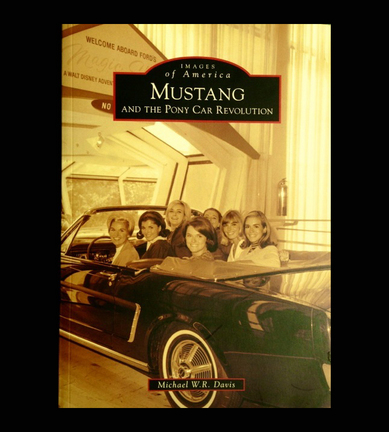Mustang and the Pony Car Revolution
Reviewed By Steve Purdy
+VIDEO
 Mustang and the Pony Car Revolution |
Mustang and the Pony Car Revolution
Written by Michael W.R. Davis
An Arcadia “Images of America Book
Book Review
By Steve Purdy
TheAutoChannel.com
Michigan Bureau
• SEE ALSO: Great historical Mustang videos at bottom of page
Veteran author Michael W.R. Davis is uniquely qualified to compile this comprehensive photographic history of the Ford Mustang. It is the story of sporty cars throughout the first half of the last century that led up to the introduction of what can arguably be called an automotive game-changer, the story of the car itself and the influence it had on the industry into the future. The introduction of the Ford Mustang in April of 1964 created a new segment - the “pony car.”
Mr. Davis, a respected historian and former PR guy, worked on Ford’s public relations staff in 1962 when Lee Iacocca cancelled a plan to import and Americanize a Ford of Germany compact car called Cardinal to compete with GM’s modestly sporty Monza. Davis reports in his insider’s introduction to the book that Iacocca thought it a “little old lady’s car,” deciding it would not be introduced here under his watch. Iacocca wanted a small, sporty, personal car but insisted it be something special. And, the iconic Mustang came along just a few years later.
That decision triggered planning to build a sporty car on a Falcon platform using many off-the-shelf parts. The introduction of that car, the 64 ½ Mustang, launched at the New York Worlds Fair defined an entirely new genre of affordable, sporty cars for the U.S. consumer.
This book is particularly timely as Mustang celebrates its 50th anniversary with the introduction of the latest generation at the 2014 New York International Auto Show. A variety of PR efforts, including displaying a car on top of the Empire State Building after cutting it into sections to get it up there, accompanied the launch. This sixth generation car represents the newest step in the amazing evolution of the Mustang that Davis documents broadly.
The format of the book (as with all the Acadia, Images of America series) uses carefully chosen archival photographs with extensive captions, to tell the story. Certainly, a picture is worth a thousand words, as they say, but a well-captioned photo can be worth exponentially more. And, as any writer will attest, the distillation of essential information into the shortest possible text is most difficult. Davis does a masterful job of telling this important Mustang story within a broad and interesting context.
In order to fully understand the automotive and cultural history that led up to Ford’s prophetic decision to launch this risky project, author Davis goes all the way back to the 1920s defining the first progenitor to be a Model T Runabout. He spends three fun chapters exploring dozens of other cars from many manufacturers over the ensuing decades that helped develop this formula. We see not only a variety of production progenitors but concept cars, engines, chassis details and plenty of marketing stories as well.
Then, in succeeding chapters, Davis illustrates each generation of the Mustang with the precision and detail only his insider’s view could compile. He continues to compare each to the competition rounding out the development and evolution of the pony car. He also easily makes and illustrates the case that the pony car led to another important genre - the muscle car.
Perhaps that will be his next book.
This is Mike Davis’ eighth book with Arcadia.
Mustang and the Pony Car Revolution, $21.99, Arcadia Publishing. Available at local retailers, online bookstores, or through Arcadia Publishing at www.arcadiapublishing.com 888-313-2665
• EDITORS NOTE: Why I Didn't Buy A 1964 Mustang in 1964


